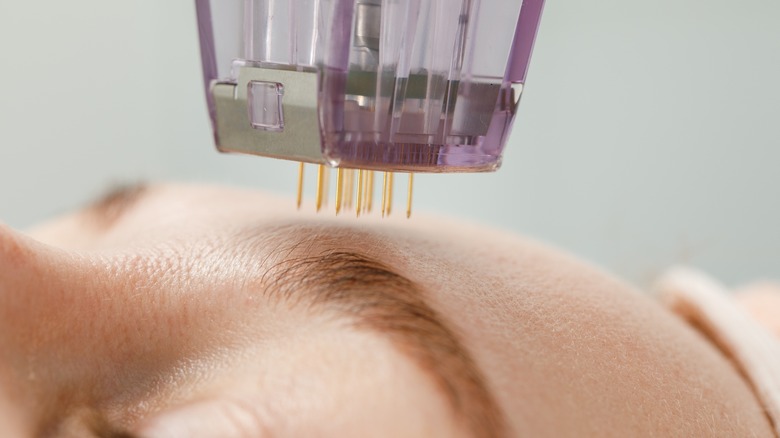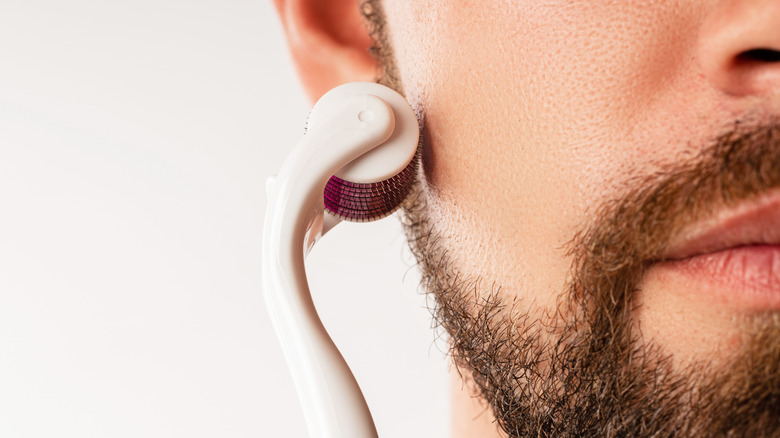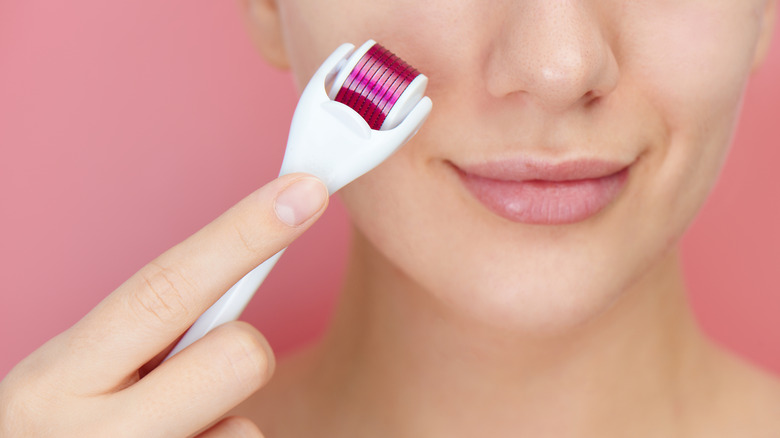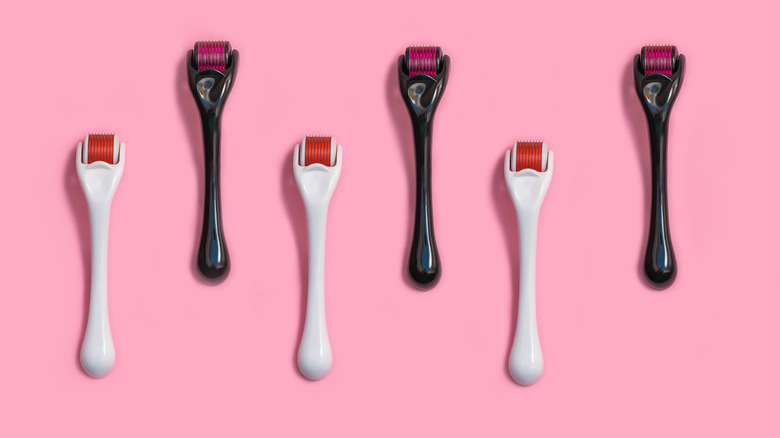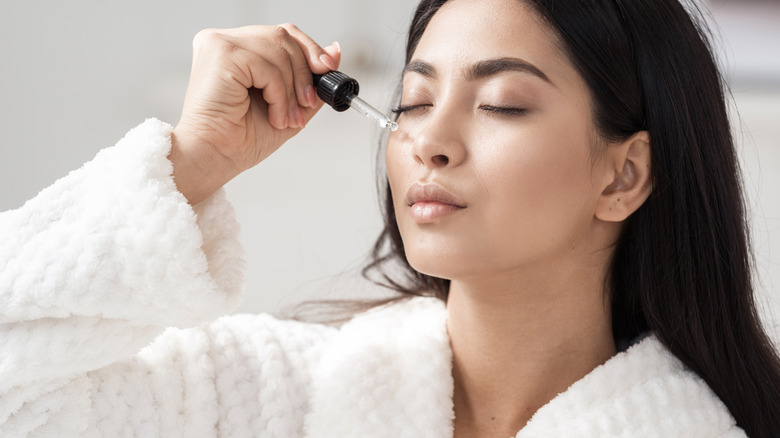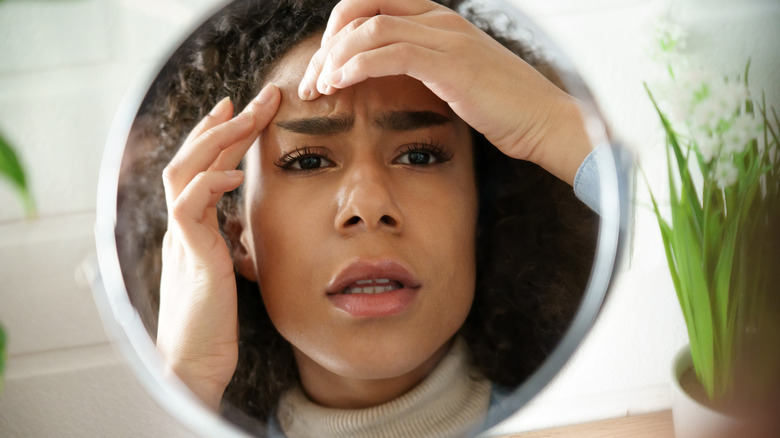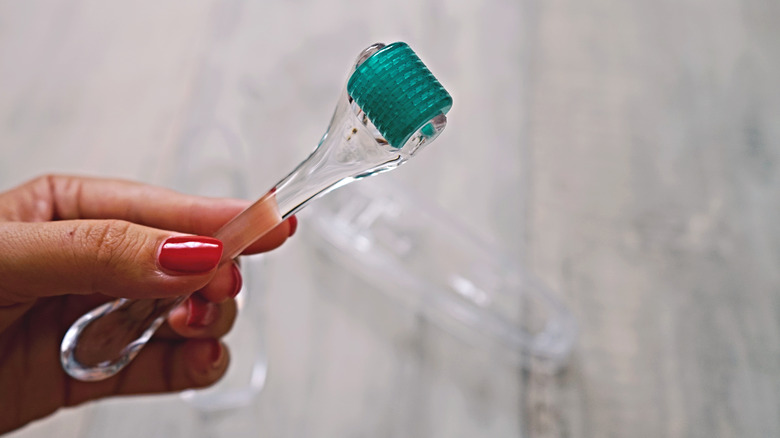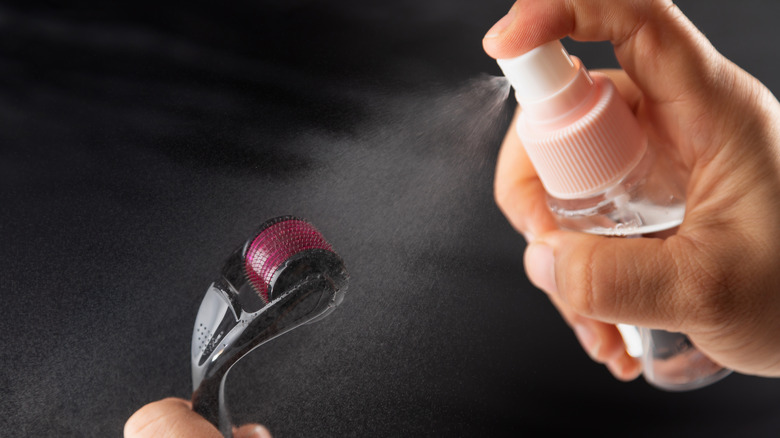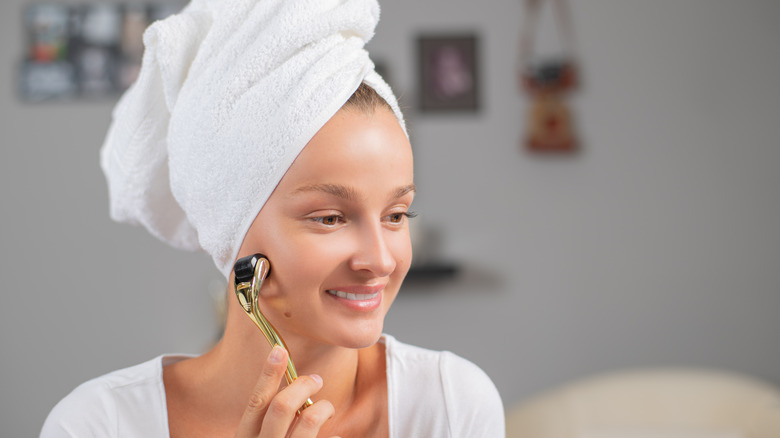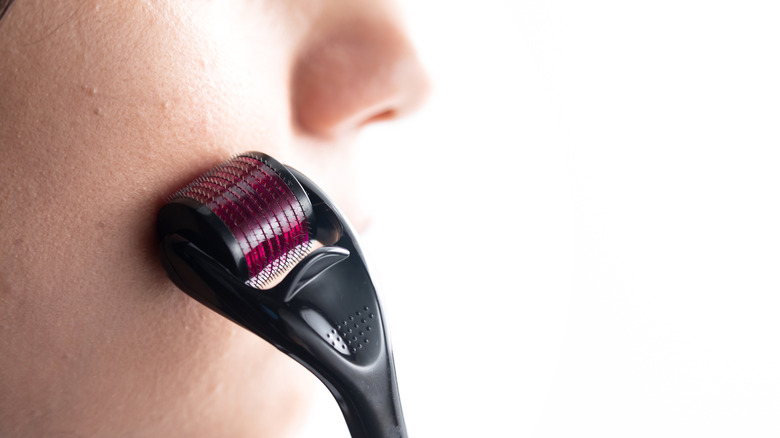The Ultimate Guide To Dermarolling
We may receive a commission on purchases made from links.
If you're on social media, you've no doubt caught on to the dermarolling craze at some point and wondered if the hype is worth it or whether this is just another passing beauty trend. In case your feed is primarily filled with videos of dogs being their amazing selves, you might not have a clue what we're talking about right now, so let's get that out of the way: Dermarolling consists of using a small handheld tool embedded with small needles that you roll over your face to help with common skin concerns like acne scars (via Teen Vogue). If "ouch!" is your initial reaction, you're not alone.
While this beauty treatment can seem painful (and super crazy) there are actually some benefits when doing it on a regular basis. "Dermarolling ... is a minimally invasive therapeutic approach that helps promote new collagen formation by creating micro punctures in your skin," board-certified dermatologist Shereene Idriss told Huda Beauty. "It's effective because it works universally on all skin types, although I caution darker skin tones to practice sun-safe habits after treatment as they may be more prone to hyper-pigmenting," she adds.
If it sounds like dermarolling can solve all your skin woes, you might be tempted to dive in head first, but before you proceed to make microscopic punctures in your skin, read on for everything you need to know about dermarolling — from how it differs from microneedling to choosing the best device for your skin concerns.
The difference between microneedling and dermarolling
You might have heard people using the terms dermarolling and microneedling interchangeably, but it's important to know that these two treatments are not the same. Microneedling refers to a procedure performed by medical professionals that cause some minor trauma to the skin, while dermarolling refers to the DIY version of this procedure (which causes a lot less trauma), according to Healthline.
Speaking to Teen Vogue, Dr. Joshua Zeichner, dermatologist, explains that the main difference between microneedling and dermarolling lies in the length of the needles and the tools used. "The at-home devices tend to be rollers because they are safe and easy to use. Most of the professional treatments tend to be pens," he explains, adding, "For safety reasons, any micro-needling device that you use at home will not penetrate deep into the skin. For this reason, at-home rollers are more effective in treating hyperpigmentation rather than acne scars." Zeichner says that the reason a dermaroller won't be able to target acne scars as effectively is because the collagen responsible for their formation is buried under more layers of skin than a dermaroller's needles can reach.
Naturally, dermarolling is a much cheaper treatment. According to Focal Point Spa, dermarollers can cost anything between $20 and $100. Some are even more expensive than that. The price alone should tell you that the results won't nearly be the same as that of an in-office microneedling treatment, which can add up to $1,000, esthetician Kerry Benjamin told Stylecaster.
Benefits of dermarolling
Even though dermarolling won't yield the same results as microneedling, your skin can still reap some benefits from this at-home treatment.
"It helps mostly with skin rejuvenation, acne [scarring] and other scarring, enlarged pores, wrinkles, and even stretch marks," board-certified dermatologist Shereene Idriss told Huda Beauty. She adds that the small tears created in the skin encourage the body to send more blood to your face and amp up collagen production. This helps new skin cells to develop, which, in turn, helps to repair blemishes. If your skin is mature and lacking elasticity, the extra collagen production can help wrinkles and fine lines to diminish as well.
Aside from giving you a youthful glow, dermarolling can also be used to help your skin absorb the products you use a little better, Petunia Skincare reports. Dermarolling opens your pores, allowing products to reach past the epidermis to the dermis. According to Greatist, dermarolling can also take care of thin skin and discoloration. Another lesser-known benefit is increased hair follicle growth, which means dermarolling might be able to help treat hair loss.
Dermarolling comes with some risks
While dermarolling might seem like a pretty straightforward at-home treatment, you should keep in mind that there are some risks involved. For one, depending on the dermaroller you use, you might actually cause more scars to develop on your face instead of clearing up existing ones, Dermstore warns. If the dermaroller's needles are too long or bent, it can cause serious damage to your skin and even lead to infections. Using the dermaroller incorrectly can also lead to skin damage.
Aside from infections and scarring, you should also keep in mind that dermarolling can cause redness that persists for a couple of days, and your skin will be more susceptible to sun damage afterward. According to Petunia Skincare, redness isn't the only thing you might deal with — there's also a chance that your skin can become severely irritated, especially if you don't space out your dermarolling sessions. Going overboard can lead to breakouts, bleeding, and even swelling. You might also cause damage to the deeper tissues of your skin. Yikes!
Last, but not least, keep in mind that the results from dermarolling will not equal that of a microneedling session. No matter what benefits you're trying to reap, whether it be reducing the appearance of scars, wrinkles, or stretch marks, dermarolling alone likely won't 100% provide you with the results you seek. It works better if you combine it with other treatments that include professional microneedling, chemical peels, or fractional laser skin resurfacing.
Dermarolling is more affordable than other facial treatments
One thing that makes dermarolling a very attractive skincare treatment is its low cost. Treatments that promise similar results are much more expensive. For example, Botox, which is primarily used for its ability to do away with wrinkles, costs around $300-$500 per session, according to The Skin Care Center. Laser skin resurfacing treatments, on the other hand, can range between $1,000-$2,000 per session, depending on whether you opt for an ablative or non-ablative treatment (via the Dermstore).
As with all skin treatments, more than one session is typically required to see the desired results, which means it can get pretty costly. For an in-office microneedling treatment, you'll pay a minimum of $600, but this quickly adds up depending on how many sessions you need, and you might spend up to $4,200 to see the desired results (via Healthline).
In contrast to these expensive treatments, paying $20-$50 for a dermaroller seems like a no-brainer. These devices can last up to eight months if you look after them well, so you will be saving a ton of cash (via Micro Glow).
How to choose the right dermaroller
If you're ready to give dermarolling a whirl, you need to know what to look for when you choose a device. Not all dermarollers are created equal, and you'll want to buy one that will cater to your specific skin concerns.
Speaking to Huda Beauty, board-certified dermatologist Shereene Idriss explains that the magic lies in the needles. Some skin issue need deeper penetration to clear up than others. Idriss recommends you opt for 0.25mm – 0.5mm needles if your main concern is wrinkles and fine lines or large pores. If you're looking to reduce the appearance of light scars you have from acne, surgical procedures, chicken pocks or even stretch marks, a 1mm needle will get the job done.
Deeper acne scars, as we mentioned, need deeper penetration, and Idriss recommends a 1.5mm needle for this purpose. Dermarollers with these needles come with a warning label, though. Idriss says that, unless you are accustomed to using a dermaroller, using a device with 1.5mm needles is not recommended. In fact, Idriss recommends that, if your skin concerns require needles longer than 1mm, your best bet is going to a medical professional. "Needles longer than 1.5 mm should not be used on the face. Longer needle lengths (2.0mm, 2.5mm, 3.0mm) are used for more severe cases, deep scars and wrinkles, rejuvenation of badly damaged skin, in areas other than the face and should only be performed by a licensed professional," Idriss warns.
How to use a dermaroller safely
Speaking to Teen Vogue, Dr. Joshua Zeichner explains the most important thing you need to do before starting a dermarolling session is to wash your face and inspect it for any open wounds, signs of infection, or rashes. If any of these conditions are present, you need to hold off on dermarolling until the condition clears up. If you don't, you'll not only make it worse, but you'll also spread that harmful bacteria all over your new roller.
Next up, Healthline recommends properly disinfecting your dermaroller by soaking it in 70% isopropyl alcohol. Let it sit for around five to 10 minutes. Before you subject your skin to the needles, you should wipe your face with 70% isopropyl alcohol and apply some numbing cream, especially if the needles are longer than 1.0 mm. Once you washed off the numbing cream, the dermarolling can begin.
Zeichner recommends using a technique similar to that of applying moisturizer: starting at the bottom of your face and then slowly moving upward. "I want my patients to avoid any action that adds to the effects of gravity. Rather than pulling down, I would rather the forces pull upwards to minimize potential future sagging of the skin," he explains.
Once you're done, it's time to wash your face with water and then clean and disinfect your dermaroller so it's ready to use for your next session. Then follow with a gentle skincare routine.
The best serums to use with a dermaroller
Since dermarolling helps the skin to better absorb products, it provides you with the perfect opportunity to use some serums to address your skin concerns. Not just any serum will do, however. Healthline warns that some serums can cause nasty reactions when used in conjunction with dermarolling. All-time favorites like vitamin C and retinol are not recommended since they can cause the skin to become irritated.
Aesthetician Laura Kearney recommends you instead opt for gentler, moisturizing serums like hyaluronic acid. Not only will it give your skin a massive moisture boost, but it will also help your skin recuperate faster after a dermarolling session, leaving you with a noticeable change in texture and tone. Celebrity esthetician Joshua Ross agrees that you should stay away from skincare containing actives like BHAs, AHAs, and retinols after your dermarolling session. He told Skincare.com that applying an oil-based serum after dermarolling can help to keep the skin moisturized and add that radiant glow we all dream of.
How to take care of your skin after dermarolling
While dermarolling can help you get the glowing skin you want, you'll only reap the benefits if you follow a good aftercare routine. First of all, you need to make sure you wear sunscreen to prevent any burning, tanning, or pigmentation (via Be Beautiful). The best course of action would be to avoid the sun altogether.
Dr. Joshua Zeichner, dermatologist, told Teen Vogue the skincare routine you choose to follow after dermarolling should align with the skin concerns you're trying to address. For example, if hyperpigmentation is your main issue, consider applying a gentle vitamin C serum after the treatment (patch test first in case your skin can't handle it) — whereas skin that has wrinkles or feels dry or textured will reap the best benefits if you apply a serum containing hyaluronic acid. You can also apply other gentle serums like niacinamide. If your skin seems irritated after the treatment, applying some ice packs to your face can help your skin to calm down.
It takes time to see results
As with most facial treatments, results after dermarolling won't be visible instantly. In fact, you'll have to wait a few weeks before you start noticing changes to your skin. So, if you expect to see glowing skin right after your first session, you're setting yourself up for disappointment (via Micro Glo).
According to Be Beautiful, the time it takes to see results is different for everyone — each skin type will react differently to dermarolling, and the results will also depend on the type of roller you use and how often you do dermarolling (once a week is recommended). You can expect to start seeing results within two to six months, but some skin issues take longer to react to dermarolling than others, so be patient. If you're using dermarolling to target wrinkles or hyperpigmentation, you'll likely only start to see a difference after the six-month mark.
The reason results are not instant is because dermarolling affects skin tissues not visible to the naked eye, which means the changes that take place take time to become visible on the surface as the skin sheds its cells. As long as you stay patient and stick to regular dermarolling sessions, the results should eventually become visible. So take heart, good things take time.
Dermarolling isn't for everyone
While dermarolling can seem like a miracle treatment, it's not a good option for everyone. For starters, experts don't recommend you start this treatment at a young age. "Typically I don't recommend that people in their 20s dermaroll unless they have a specific skin condition that warrants it, [such as] acne scarring that may respond to needling," esthetician Penn Smith told the Greatist. On the other hand, dermarolling also isn't recommended for those who have mature skin that is incredibly thin.
You should also steer clear of dermarolling if you have any skin conditions like sunburn, cuts, or scratches on your face, Health Centre warns. According to Be Beautiful, you should avoid dermarolling if you're currently dealing with an acne flare-up or any breakouts. The treatment can move bacteria around your face, causing even more breakouts.
If you suffer from any inflammation or infections like herpes, you should also steer clear of this treatment. "People with autoimmune diseases, diabetes, psoriasis, and eczema may not be good candidates for needling," Smith says, adding that she usually recommends people go to a professional for their first dermarolling session. They will be able to gauge whether it's safe to perform the procedure on your skin and will educate you on whether the medications you're taking are safe to use alongside the treatment. Blood thinners, for example, can turn this treatment into a nightmare, and you should stop taking these meds at least 14 days before you attempt dermarolling.
What to look for when buying a dermaroller
While most of us can't resist a good deal, you shouldn't be looking to buy a bargain when you shop for a dermaroller. According to the Greatist, dermarollers have a wide price range — you'll encounter rollers that sell for as little as $10 while others cost more than $100. While it might be wise to steer clear of the cheapest ones, the most important factor to consider is the materials the roller is made of. "It is important to research and purchase a roller that has real needles and not metal barbs," esthetician Penn Smith says. She adds that a mid-range price roller should be fine, but that you should check its reviews first.
Healthline advises you only opt for dermarollers with needles made from either stainless steel or titanium. Both of these compounds will work just fine, but each has its pros and cons. Stainless steel is easier to sterilize and sharper than titanium, but the needles will get blunt much sooner than titanium needles. Titanium is a much stronger compound than stainless steel, which means you'll have a dermaroller that doesn't get blunt as quickly, but it won't be as sterile as stainless steel needles. One isn't necessarily better than the other, and the roller you choose will depend on your personal preference.
Smith also advises that you inspect your roller when you receive it to ensure there aren't any bent needles or, even worse, any needles covered with rust.
How to clean your dermaroller
It's crucial you properly clean your dermaroller before and after each use. Speaking to Healthline, specialist in acupuncture and Chinese medicine at Lion's Heart, Dr. Kim Peirano explains that the best way to clean your dermaroller is with 70% isopropyl alcohol spray. Alternatively, you can dissolve a denture tablet in hot water and let the roller soak in that.
If you want to make sure you get rid of any residue on the needles, Dermrollers recommend you put your dermaroller in a mixture of water and liquid detergent and gently scrub the needles with a brand-new toothbrush, taking care not to get too scrub-happy — too much pressure can bend the needles. Once you're done, rinse your dermaroller under hot water. Another option you can consider is using a sponge. This is a little easier than scrubbing each needle with a toothbrush: Simply wet a sponge in soapy water and then roll the needles over the sponge like you would on your skin. This will effectively remove any residue and debris from your dermarolling session.
While these methods are great to help you clean your dermaroller, it's super important that you still soak it in 70% isopropyl alcohol to kill any remaining germs. You should always do this before and after each dermarolling session. Last, but not least, don't share your dermaroller with anyone since this will put you at a higher risk of developing irritation and infection.
Is dermarolling safe to do at home?
Before performing any sort of invasive skincare treatment at home, it's wise to do your research and figure out whether skincare experts, like dermatologists, actually recommend you perform these procedures by yourself. So, do dermatologists consider dermarolling to be a safe DIY treatment? Fair warning: You might not like the answers.
"I actually wouldn't recommend dermarolling at home," esthetician Jess Possemato told the Greatist. "I think it can do more harm than good, and it's always better to go to a licensed professional [for microneedling]." According to The Cut, dermarollers can mostly be used safely at home if, and only if, the needles are less than 0.25mm long. In fact, the FDA hasn't approved the at-home use of dermarollers that have needles longer than 0.3mm. Despite this, many dermarollers out there have needles that are way longer than that.
Speaking to Refinery29, advanced aesthetician Lisa Montlake explains that, these days, you get dermarollers that have needles that are the same length as the tools used by professionals for microneedling. This is incredibly dangerous. "Originally, you had to have either a medical background or be an aesthetician trained in microneedling to be able to access them and perform the treatment," she explains, adding, "The wrong technique can easily cause micro-tears in the skin, leading to scarring and hyperpigmentation." You also put yourself at risk of having allergic reactions to some serums post-needling since microneedling increases absorption.
Does dermarolling hurt?
If you're wondering whether dermarolling hurts, you're not alone. The good news is this treatment isn't supposed to be painful. Because a dermaroller is designed to be used at home, the needles aren't long enough to puncture the deeper, more sensitive layers of the skin, Marie Claire reports. Everyone's pain tolerance is different, so it might be more uncomfortable for some than it is for others.
Needles over 1.5mm long, however, will likely make their presence known because they penetrate deeper into the skin. Since these are the needles used by professionals, you'll be subjected to a numbing cream beforehand to minimize any pain or discomfort during the procedure. According to Micro Glow, those new to dermarolling often find it a little more uncomfortable than those who are used to the treatment. You'll likely be very aware of the feel of the needles on your skin and might even experience some minor burning or tingling. This isn't usually anything to worry about. However, you should reassess how you're using your dermaroller if you experience a lot of discomfort or pain. It might be that you're applying way too much pressure or it could be an indication that you have very sensitive skin.

